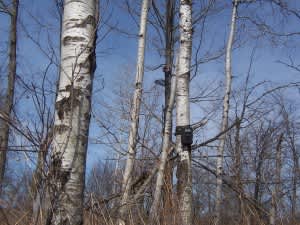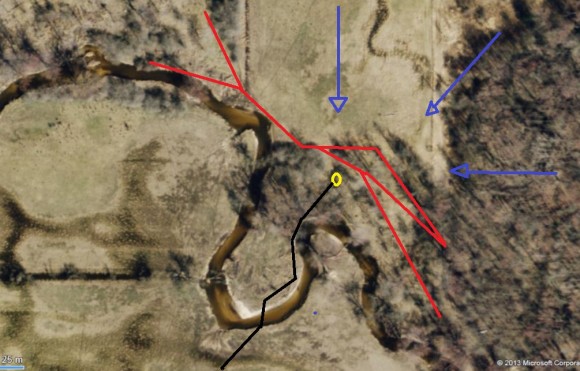Whitetail Weekly: Getting Your Stands “Spot On”
Whitetail Weekly 01.28.13

As any deer hunter knows, getting your stand in just the right spot can be a process of trial and error even when you think you have it all figured out ahead of time. Often times when you think you know just how a deer will behave they show you that you were close, but not perfect. Often times getting a stand in the exact right spot can take a season or two of actual in-stand encounters or scouting but once they are in the right spot they can be a magical place to spend a hunt.
Our property currently has roughly 15 stands and while I like to think that most of them are in good spots I’m certainly not naive enough to think that they are all in the perfect spot within their respective area. We actually find ourselves debating quite frequently on whether or not we should tweak a stand a little bit to try and make it better. Even one of our top stands, the stand with the most encounters this past season, is often the subject of “should we move it” discussions. Of all the stands we have hung there are three only a few stands that I would consider to be “spot on” stands.
In order for a stand to be considered “spot on” there are three parameters to consider and all three must be met. Meeting one or two of the parameters is a good start, and can make for a really good hunting spot (the stand I mentioned above meets two of the three) but unless you have all three you are always running a certain degree of risk when hunting that spot. The three factors I like to consider are access to and from the stand, scent dispersion once on stand and of course the deer useage of the area (preferably some sort of a pinch or funnel that brings them in close more often than not).
Lets take a look at a few of our stands that meet all three of these parameters and are what I consider “spot on” stand locations.

1. The River Stand: This stand utilizes a few different natural features to help it meet the three parameters and is one of my favorite stands on the property. This stand doesn’t always offer a high quantity of sightings but is a great place to catch a cruising buck heading to or from bedding areas.
Deer Useage: As you may have guess by the name, the stand is located along the river and is also located in a great natural funnel between two woodlots. That funnel, along with the river, steers the deer in a pretty predictable travel pattern and generally assures that a great percentage of the deer you see from this stand will pass through within bow range.
Scent Dispersion: Hunting this stand with a north, northeast or even a straight east wind takes your scent out over the river and into the pasture. Our experience has shown us that seeing deer in the pasture is a rare occurence and having your scent over the pasture offers very little risk in terms of bumping deer. There is a slight chance that a deer could get south of the stand, between the stand and the river, but the river is so close there that on the off chance the deer go that way the river will funnel them within bow range and still offer a shot.
Access: This stand has a practically fool proof access route, as long as you have rubber boots or waders on. Accessing the stand via the south allows you to travel through the pasture (little risk of bumping deer) and then cross the river and head straight to the stand. Once you cross the river you aren’t far from the stand which means quiet access and you are also out of the normal travel patterns of the deer.

2. The Fenceline: This stand sits on the edge of one of our small kill plot food plots. It uses the pasture to it’s advantage and also takes advantage of the natural layout around the plot to get deer up close and personal.
Deer Useage: The food plot obviously encourages deer movement in the area but aside from the food plot the area is a natural north/south travel corridor and also borders a thick area of cover that the deer regularly use to travel through.
Scent Dispersion: Any east based wind will carry your wind straight out over the pasture and you run very little risk of getting winded when hunting this stand. The deer you see will generally approach from the northeast or south and will stay east of you the entire time.
Access: Accessing this stand is as simple as working through the pasture east of the stand. Since it is only hunted on an east based wind you won’t be scented as you approach and the natural topography of the pasture offers you a chance to stay behind a hill for much of the approach and as you crest the hill you can view the plot from afar and check for deer in the plot.
Those stands are what I consider “spot on” and address the three biggest issues that people run into with stand locations. It only makes sense that if the hunter can get in and out of a stand without getting busted and also run a very low risk of getting busted while on stand the end results, especially over the course of a long season, are going to be better.
Of course there are no guarantee’s in the deer woods but by putting the odds as far into your favor as possible you stand a get chance of getting the drop on whitetail. If you keep these three parameters in mind while scouting or setting stands you just may find that “spot on” location for your next stand.
Take care, and thanks for reading.
Check out Whitetail Weekly’s blog on Michigan-Sportsman.com for more deer hunting tips.

